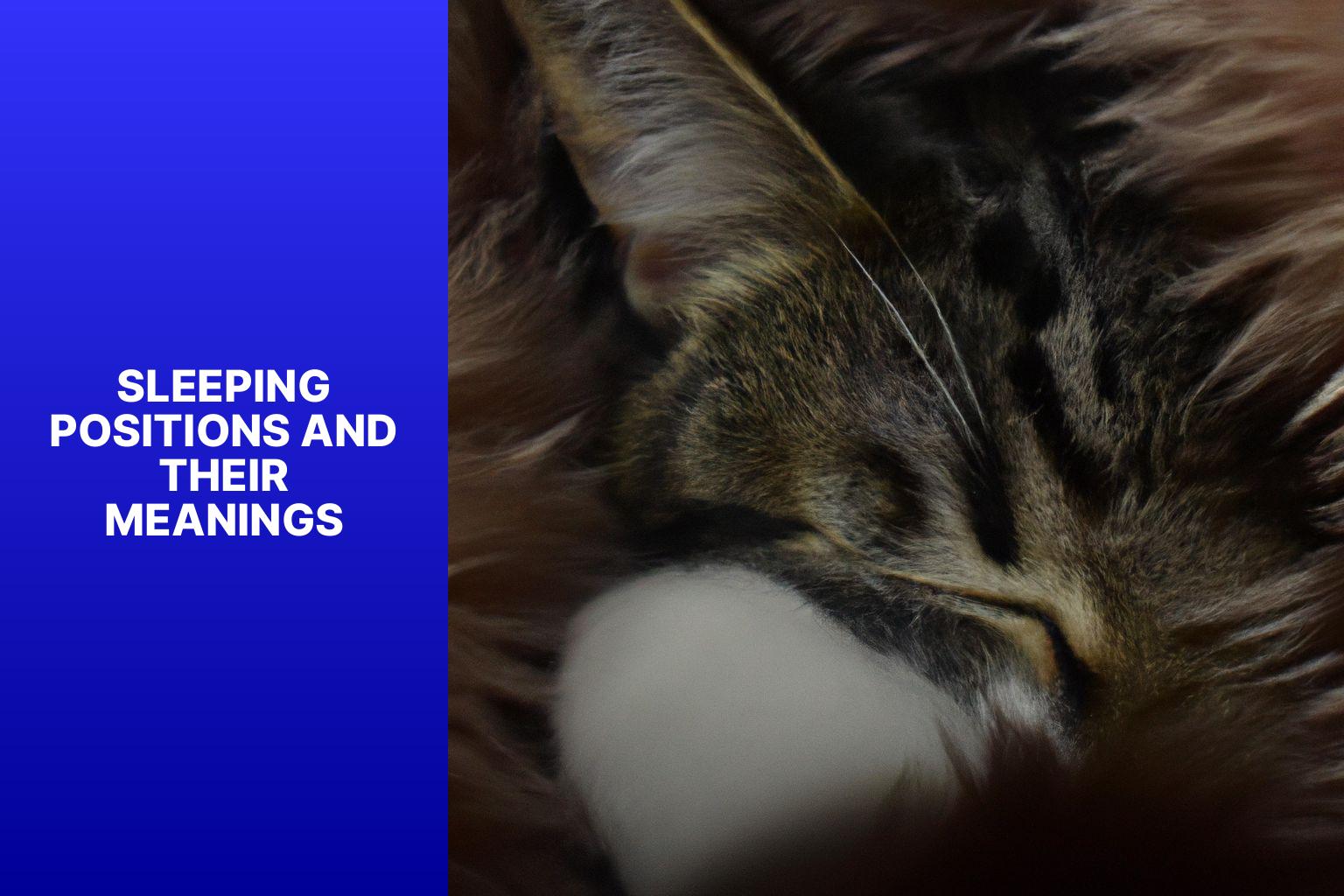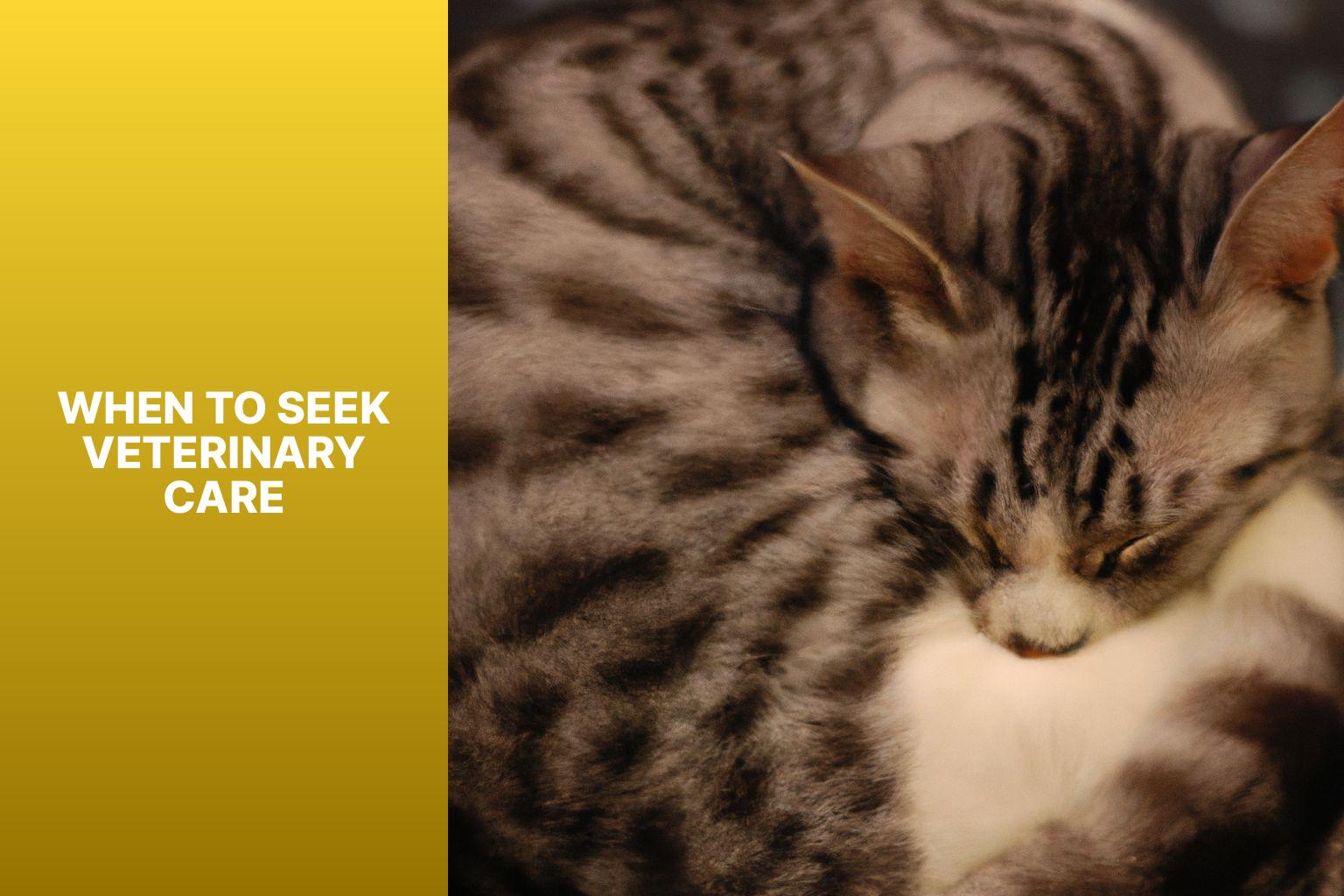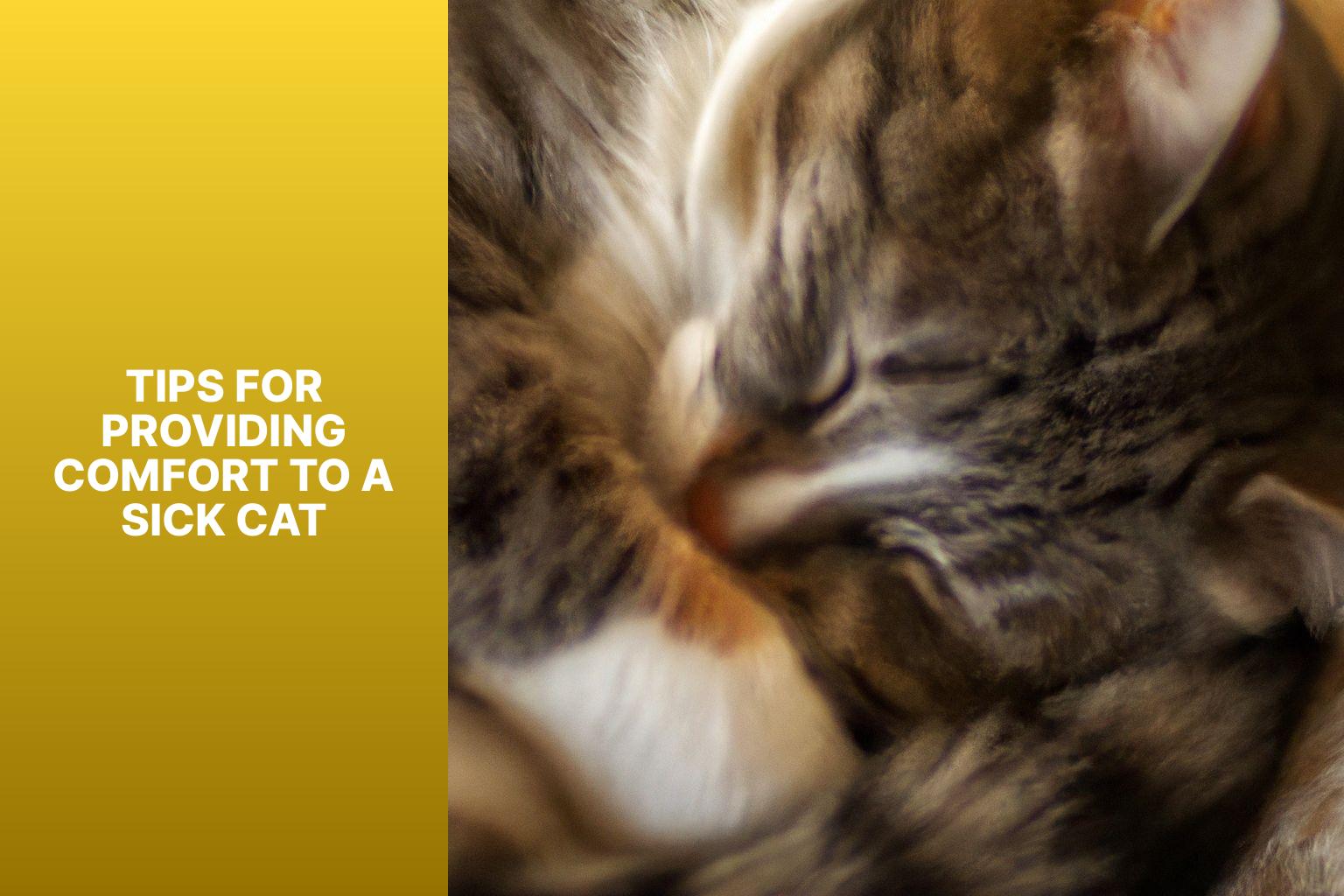Understanding Cat Sleeping Patterns
Cats are known for their unique and sometimes peculiar sleeping habits. They have a natural instinct for finding cozy spots and curling up for a nap. When a cat is sick, their sleeping positions and behaviors may change. It is important for cat owners to be aware of these changes to better understand their feline friend’s health and well-being.
To comprehend a cat’s sleeping patterns, it is essential to know what is considered normal behavior for healthy cats. They typically spend a significant portion of their day sleeping, ranging from 12 to 16 hours on average. Cats are crepuscular animals, meaning they are most active during dawn and dusk, which explains why they can be more active at night.
Different sleeping positions can give insights into a cat’s comfort level and overall health. Some common positions include curled up, stretched out, side sleeping, and paws tucked under. These positions can indicate their level of relaxation, comfort, and even their mood.
When cats are sick, their sleeping positions may change, providing potential clues about their condition. These changes can include hiding or burrowing, isolation or separation, sleeping in unusual locations, or adopting a lethargic sleeping position. These variations in sleeping behavior can suggest underlying pain, discomfort, illness, infection, or even stress and anxiety.
It is crucial for cat owners to observe their sick cats closely and look for these changes in sleeping positions to determine their well-being. If the behavior persists or other concerning symptoms arise, it may be necessary to seek veterinary care. Providing comfort, warmth, and a quiet environment can also help alleviate their distress and improve their recovery.
By understanding cat sleeping positions and the potential meanings behind them, cat owners can be better equipped to assess their pet’s health and provide appropriate care when needed.
Key takeaway:
- Cat sleeping positions can indicate their health: When a cat is sick, their sleeping positions may change, indicating pain, discomfort, illness, or stress.
- Normal cat sleeping behavior: Understanding a cat’s normal sleeping patterns can help identify any abnormal positions they may exhibit while sick.
- Seeking veterinary care: If a sick cat exhibits unusual sleeping positions or shows signs of pain, discomfort, or illness, it is important to seek veterinary care for proper diagnosis and treatment.
Understanding Cat Sleeping Patterns
Understanding Cat Sleeping Patterns
Cats have unique sleeping patterns. By observing their sleeping behavior, we can gain insights into their well-being and habits. Here are some facts about cat sleeping patterns:
1. Cats sleep for an average of 15 hours a day. They conserve energy for hunting.
2. They have sleep stages similar to humans. Cats experience deep sleep and REM sleep, during which they may twitch or move.
3. Cats are crepuscular animals, most active during dawn and dusk. They take several naps throughout the day.
4. The sleeping positions of cats can tell us about their comfort and mood. A curled-up position indicates a sense of security, while stretching out signifies relaxation.
5. Cats seek warm and cozy spots to sleep, like sunny windowsills or cozy blankets. This behavior helps regulate their body temperature.
Understanding cat sleeping patterns is essential for cat owners to ensure their pets are happy and healthy. Providing a comfortable sleeping environment and respecting their rest helps cultivate a strong bond with our feline companions.
What is Normal Sleeping Behavior for Cats?
Cats have different normal sleeping behaviors. Understanding these behaviors is important for your cat’s well-being.
One common sleeping behavior for cats is curling up in a ball. This conserves body heat and protects vital organs. Cats may also sleep stretched out, which helps them relax their muscles. Another normal position is sleeping on the side, indicating comfort and safety. Cats may also sleep with their paws tucked under for stability and quick response.
Understanding these behaviors helps you notice any changes in your cat’s sleep patterns. Changes could indicate potential issues such as pain, illness, infection, or stress. If you observe changes, seek veterinary care. Cats are good at hiding pain, so professional assessment is crucial. Providing comfort includes creating a warm and quiet environment, a cozy bed, and access to water and food.
What is Normal Sleeping Behavior for Cats?
How Do Cats Sleep When They are Healthy?
Cats have distinct sleeping patterns that provide insights into their health and well-being. Here are the ways cats sleep when they are healthy:
1. Curled Up Position: Cats curl up into a ball while sleeping to conserve body heat and protect organs.
2. Stretched Out Position: Cats lie down on their side or stomach with legs stretched out when they feel relaxed and comfortable. This position allows them to fully stretch their muscles.
3. Side Sleeping Position: Cats may sleep on their side with legs extended or slightly tucked, indicating feeling secure and content.
4. Paws Tucked Under Position: Cats occasionally sleep with paws tucked under their body to conserve warmth and protect paws.
These sleeping positions are normal and indicate good health. Cats sleep for around 12 to 16 hours a day to conserve energy and recharge.
Fact: Cats are crepuscular animals, most active during dawn and dusk. They can adjust their sleep patterns to accommodate their owner’s schedule.
Sleeping Positions and Their Meanings
Photo Credits: Www.Catcornerblog.Com by Nicholas Jackson
When our precious feline friends are feeling under the weather, their sleeping positions can reveal more than we think. In this section, we’ll uncover the meanings behind various sleeping positions of sick cats. From the curled-up position to the stretched-out position, each position holds clues about their comfort levels and potential ailments. Get ready to decode the language of cat slumber and gain insights into their well-being. Meow-velous discoveries await!
1. Curled Up Position
The curled up position, also known as the curled up position, is a common sleeping position for sick cats. Here are some characteristics and meanings of the curled up position:
– The cat’s body is tightly curled, with the tail wrapped around it.
– The paws are tucked under the cat’s body.
– The head may be tucked towards the chest or on a pillow.
– This curled up position helps cats conserve body heat for warmth and comfort.
– Cats may adopt this curled up position when experiencing pain or discomfort.
– It provides security and protection during illness or stress.
– When curled up, cats create a cozy space and prefer secluded areas.
To ensure your sick cat is comfortable, provide a warm and quiet space with soft bedding. Offer gentle affection and monitor behavior for signs of distress or worsening symptoms. If your cat’s condition worsens or they show severe pain or distress in this curled up position, seek veterinary care.
Each cat is unique, and their sleeping positions may vary. Observe your cat’s behavior and consult a veterinarian for proper diagnosis and treatment when they are unwell.
2. Stretched Out Position
The stretched out position is a common sleeping position that cats adopt when they are relaxed. Here are some steps to understand this position:
1. The cat lies flat on its side, with its legs and body fully stretched out.
2. This position helps the cat cool down by maximizing their body surface area, allowing heat to dissipate efficiently.
3. Cats in this position are usually in a deep sleep and feel safe in their environment.
4. It is a sign that your cat is content and at ease, as they expose their vulnerable belly.
5. The stretched out position also allows the cat to stretch their muscles and keep them flexible.
6. Some cats may sleep in this position to claim territory, as it makes them appear larger and more dominant.
7.
In ancient Egypt, cats were highly revered and considered sacred animals. They were often depicted in stretched out positions in wall paintings and sculptures, symbolizing their importance and divine nature. This portrayal reflected the belief that cats possessed a calm and regal demeanor, even in their sleep. Today, many cat owners find comfort in seeing their feline companions enjoy a peaceful slumber in the stretched out position, as it signifies their well-being and contentment.
3. Side Sleeping Position
The side sleeping position is common for cats and indicates their comfort and relaxation. Here are some key points to understand about this position:
1. Cat’s preference: Cats sleep on their side when they feel safe and secure.
2. Stretching out: Cats stretch their legs and body when they sleep on their side, helping them relax their muscles and release tension.
Sleeping on the side allows cats to regulate their body temperature effectively. They can expose their belly to cool surfaces or curl up tighter if they feel cold.
4. Comfort indicator: Cats that sleep on their side show that they are comfortable and trust their surroundings. This position leaves their vital organs exposed.
5. Calmness and relaxation: The side sleeping position indicates that a cat is in a state of deep relaxation and enjoying a peaceful sleep.
6. Observing dreams: Cats may twitch or move when sleeping on their side, suggesting that they are dreaming.
Note that changes in a cat’s sleeping position can indicate underlying health issues or discomfort. Monitoring your cat’s sleeping habits and noting any drastic changes can help you provide appropriate care and seek veterinary attention if necessary.
4. Paws Tucked Under Position
When a cat sleeps with its paws tucked under, it can indicate a few things. Here are some possible reasons for this paws tucked under position:
1. Comfort: Cats often tuck their paws under to find a cozy and comfortable position. This paws tucked under position helps them feel secure and relaxed.
2. Warmth: Tucking their paws under their body helps cats conserve body heat and stay warm.
3. Protection: Cats instinctively protect their vulnerable areas, like their paws. Tucking their paws under their body keeps them safe.
4. Relaxation: Cats may tuck their paws under when they are completely at ease and content.
5. Illness or discomfort: In some cases, cats may tuck their paws under if they are feeling unwell or in pain. If accompanied by other signs of illness, it’s important to monitor your cat and consult a veterinarian if necessary.
Remember, every cat is unique and their sleeping positions can vary. If you notice any changes in your cat’s sleeping behavior or signs of discomfort, seek veterinary care to ensure their health and well-being.
Common Sleeping Positions when Cats are Sick
When cats feel under the weather, their sleeping positions can often reveal important clues about their health. In this section, we’ll dive into the common sleeping positions that cats tend to adopt when they are sick. From hiding or burrowing to isolation or separation, sleeping in unusual locations, and displaying lethargic sleeping positions, we’ll uncover the subtle signs that can help us understand and care for our feline friends during their times of illness. So, let’s explore the fascinating world of cat sleeping positions when they are not feeling their best. Meow!
1. Hiding or Burrowing
When cats are not feeling well, they may exhibit a natural behavior of hiding or burrowing, which indicates their need for comfort and protection. This sleep position is often seen more frequently in cats when they are sick, as it helps them cope with discomfort or pain. If your cat consistently hides or burrows and shows other signs of illness such as loss of appetite, lethargy, or unusual behavior, it is crucial to seek veterinary care. You can create a warm and cozy hiding spot for your sick cat by providing a soft blanket or bed in a quiet area of your home to offer them comfort.
2. Isolation or Separation
Isolation or separation is a prevalent sleeping position for sick cats. When cats are not feeling well, they tend to choose to sleep alone and away from others. They seek solitude and rest in separate rooms or secluded areas such as closets or under furniture.
When feeling unwell, cats often seek isolation to rest and recover undisturbed. They withdraw from social interactions, avoiding touch or contact with their owners and other animals in the household. By isolating themselves, cats effectively minimize stress and anxiety, which can potentially worsen their condition. Solitude allows them to conserve energy and focus on healing.
It is crucial to closely monitor cats displaying isolation or separation sleeping positions. If this behavior persists or is accompanied by other concerning symptoms, it may indicate a more serious underlying health issue that necessitates veterinary care.
Understanding the meanings behind different cat sleeping positions when they are sick helps pet owners better evaluate their cat’s condition and provide appropriate care and comfort.
3. Sleeping in Unusual Locations
Cats have a tendency to sleep in unconventional places, such as cabinets, closets, or small boxes, because of their natural instincts. They are drawn to confined spaces that bring them a feeling of safety and security.
Cats may opt for sleeping in elevated areas like the top of bookshelves, cabinets, or cat trees. This allows them to observe their surroundings and maintain a sense of control.
Another behavior exhibited by cats is sleeping in hidden or secluded spots like under the bed, behind furniture, or in tight corners. This behavior is frequently observed in stressed or anxious cats who are seeking a peaceful and private environment.
Cats might also search for warm spots to sleep, such as near heating vents, on top of radiators, or in sunny spots by windows. This behavior helps them regulate their body temperature and stay warm.
These unique sleeping patterns can indicate that a cat is seeking comfort or trying to alleviate discomfort. It’s crucial to monitor any changes in your cat’s behavior and consult a veterinarian if you notice any signs of illness or distress.
Providing a comfortable and secure environment for a sick cat can aid in their speedy recovery.
4. Lethargic Sleeping Position
When a cat is sick, it may sleep in a lethargic sleeping position. Common lethargic sleeping positions include:
– Hunched position: A sick cat may sleep hunched up, conserving energy and protecting itself.
– Lying on side: A cat lying on its side with stretched out legs indicates weakness or discomfort.
– Hidden or tucked away: A sick cat may choose to sleep in hiding spots or tucked away corners, seeking solitude.
– Reduced grooming: If a cat is unwell, it may not groom itself as often.
It is important to take a lethargic sleeping position seriously as it may indicate an underlying health issue. If a cat consistently displays this position, seeking veterinary care is recommended for diagnosis and treatment.
What Do Cat Sleeping Positions Indicate?
Ever wondered what your cat’s sleeping positions could reveal about their health? In this section, we’ll uncover the hidden messages behind your feline friend’s naptime postures. From signs of pain or discomfort to indications of illness or infection, and even cues of stress or anxiety, each distinctive sleeping position holds fascinating insights into your cat’s well-being. So, let’s dive in and decode the secrets of their slumber!
1. Pain or Discomfort
When observing cat sleeping positions, it is important to pay attention and understand certain postures that can indicate pain or discomfort. These positions include hunching or crouching, laying on one side, restlessness, guarding the body, and seeking warmth.
Cats may hunch or crouch while sleeping to protect their sensitive abdominal area, indicating pain or discomfort. When cats sleep on one side and tuck their legs in, it may relieve pressure on specific areas of their body, but it could also be a sign of pain or discomfort.
Restlessness, characterized by constantly changing positions and getting up and lying back down frequently, is another indicator of possible discomfort. Cats may sleep with their paws tucked under their body and their tail wrapped around them to guard vulnerable areas and minimize movement, suggesting pain or discomfort.
In addition, cats in pain may seek warmth by curling up tightly or snuggling against a heat source, as a behavioral change to find comfort and relief.
It is important to note that these sleeping positions alone do not provide a definitive diagnosis. If you notice your cat displaying these positions and suspect they are experiencing pain or discomfort, it is best to consult with a veterinarian for proper evaluation and treatment.
2. Illness or Infection
When a cat is sick, it may show signs of illness or infection through its sleeping position. A lethargic sleeping position, where the cat sleeps longer and lacks energy, is often observed in sick cats.
Sick cats may choose unusual locations to sleep, such as under furniture or secluded areas. Changes in sleep patterns, such as sleeping more or having difficulties falling asleep, can be indicative of illness or infection in cats.
Neglecting grooming and having a messy appearance are also common behaviors in sick cats. If you notice any of these sleeping positions or behaviors in your cat, it is important to monitor its overall health and seek veterinary care if needed.
A veterinarian will examine your cat and provide the appropriate treatment. To provide comfort to a sick cat, make sure to provide a warm and quiet space with soft bedding, a clean environment, and appropriate food and water. It’s crucial to observe the cat’s behaviors and consult with a veterinarian for specific advice on caring for your sick cat.
3. Stress or Anxiety
When it comes to cat sleeping positions, certain positions can indicate stress or anxiety. Here are some common positions and their indications:
1. Hunched or Crouched Position: Stressed or anxious cats may hunch or crouch while sleeping. This indicates that they are experiencing stress or anxiety and are on high alert and ready to react.
2. Tail Wrapped Around Body: If a cat wraps its tail tightly around its body while sleeping, it may indicate stress or anxiety. This self-comforting position helps them feel more secure in times of stress or anxiety.
3. Hiding Under Furniture: Stressed or anxious cats may choose to hide under furniture while sleeping. This allows them to feel protected and secluded from potential stressors, helping them cope with stress or anxiety.
4. Rolled into a Ball: When a cat curls up into a tight ball while sleeping, it can be a sign of stress or anxiety. This position helps them conserve heat and protect vulnerable areas of their body during times of stress or anxiety.
Pro-tip: If you notice your cat displaying these stress or anxiety-related sleeping positions, it’s important to identify and address the underlying cause. Providing a safe and calm environment, offering interactive playtime, and considering pheromone diffusers may help alleviate their stress and improve their overall well-being.
When to Seek Veterinary Care
Photo Credits: Www.Catcornerblog.Com by Jack Thomas
When to Seek Veterinary Care
Knowing when to seek veterinary care for your cat is crucial for their health and well-being. Here are some indications that it’s time to consult a veterinarian:
– Unusual behavior: Sudden changes in behavior like excessive salivation, aggression, or lethargy may indicate an underlying health issue.
– Loss of appetite: If your cat refuses to eat for more than 24 hours, it is a cause for concern.
– Changes in litter box habits: Any significant changes in your cat’s litter box behavior, such as difficulty urinating or defecating, can indicate a urinary tract infection or other health problem.
– Weight loss or gain: Significant weight loss or gain can be a sign of various health conditions, including diabetes or thyroid issues.
– Visible signs of pain or discomfort: If your cat is limping, has difficulty jumping or grooming, or shows signs of pain when touched, seek veterinary care.
Remember, cats are masters at hiding their illnesses. Pay attention to any changes in their behavior or physical well-being. If you notice any of these signs, seek veterinary care promptly to ensure the best possible outcome for your cat’s health.
Tips for Providing Comfort to a Sick Cat
Photo Credits: Www.Catcornerblog.Com by Bruce Davis
Providing comfort to a sick cat is essential for their well-being and recovery. Here are some tips for providing comfort to a sick cat:
1.
Warmth: Keep your cat warm with a soft blanket or heating pad. This can reduce discomfort and promote relaxation.
2.
Quiet Space: Set up a calm area where your cat can rest undisturbed. Reduce noise and foot traffic to make them feel safe and secure.
3.
Comfortable Bedding: Give your cat a cozy bed or cushion made of soft, easy-to-clean materials.
4.
Hydration: Make sure your cat always has access to fresh water. Encourage hydration to prevent dehydration, which is important if their appetite is decreased.
5.
Gentle Stimulation: Interact gently with your cat, such as softly stroking or playing if they respond well. Avoid overstimulation, as too much activity can be overwhelming for a sick cat.
Providing a soothing environment played a significant role in the recovery of my cat when they became ill. I created a cozy corner in a quiet room with a soft blanket and a heated bed. Fresh water was always nearby. With patience and love, I gently stroked my cat to offer comfort. Over time, my cat showed signs of improvement, regaining their energy and appetite.
Some Facts About Cat Sleeping Positions When Sick:
- ✅ Most cats won’t show signs of pain because they try to hide their vulnerability to avoid predators. (Source: Our Team)
- ✅ The “loaf” position, where a cat curls her front paws under her body, may suggest a paw injury or discomfort. (Source: Our Team)
- ✅ Sleeping on the side could indicate breathing difficulties, such as asthma or heart problems. (Source: Our Team)
- ✅ If a cat starts sleeping in the litter box, it may be a sign of a urinary health problem like a urinary tract infection. (Source: Our Team)
- ✅ Sleeping with eyes half open could be due to an injury to the nictitating membrane, and any eye problem should be checked by a veterinarian. (Source: Our Team)
###Reference Data (Source: Our Team):
Source: https://betterwithcats.net/cat-sleeping-positions-when-sick/ Most cats won’t show signs of pain because they try to hide their vulnerability to avoid predators. There are certain sleeping positions that can indicate if a cat is sick. The “loaf” position, where a cat curls her front paws under her body, may suggest a paw injury or discomfort. If a cat sleeps flat on her stomach with all paws outstretched, she may be trying to cool down and could be at risk of heatstroke. Sleeping on the side could indicate breathing difficulties, such as asthma or heart problems. If a cat starts sleeping in the litter box, it may be a sign of a urinary health problem like a urinary tract infection. Sleeping with eyes half open could be due to an injury to the nictitating membrane, and any eye problem should be checked by a veterinarian. Other signs of illness in cats include behavioral changes, changes in appetite and litter box use, changes in appearance, and increased vocalization. It’s important to take your cat to the vet regularly and seek medical help if you notice any signs of distress. These sleeping positions are not definitive proof of illness, so it’s best to consult a veterinarian for a proper diagnosis. Source: https://www.fveap.org/cat-sleeping-positions-when-sick/ – Sleeping positions can indicate if cats are hiding or in pain – Cats sleeping curled up in a ball may be too cold or have injuries – Cats sleeping flat on their back may be too hot or stressed – Cats sleeping flat on their stomach may be stretching or trying to cool down – Cats sleeping in a cat loaf position may have paw problems – Cats sleeping in a meatloaf position may have chronic kidney disease or be dying/old – Cats sleeping on their side may have breathing difficulties – Cats sleeping with one eye open may have eye conditions or be sick – Cats sleeping with their head pressed against something may be sick – Sleeping habits can also indicate sickness, such as sleeping with other cats or sleeping too much – Other signs of an unwell cat include changes in interaction, lethargy, changes in appetite and weight, decreased grooming, excessive vocalization, and litter box issues – Restlessness and meowing or crying when not sleeping can indicate heart disease – Funny sleeping positions are usually just cozy, but deep sleep can make them look dead – It can be difficult to determine if a cat is sick, so it’s important to pay attention to other signs of illness – Sleeping positions can be confusing, so it’s important to look for other signs of illness – This information is provided by Amy Sawy, a veterinary professional with 15 years of experience. Source: https://mrbosscat.com/cat-sleeping-positions-when-sick/ Cats love to sleep, with the average cat sleeping around 15 hours a day. Lethargy can also be a sign of sickness or depression. Cats may use various sleeping positions when they’re sick, some of which can indicate underlying issues or discomfort. One common position








